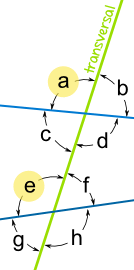Transversal – a line that crosses at least two lines
The red line is the transversal in each example:
 |
||
|
Transversal crossing two lines
|
this Transversal crosses two parallel lines |
… and this one cuts across three lines |
When a transversal crosses the two parallel lines above, there are many different angles created.
Vertical Angles – are the angles opposite each other when two lines cross

In this example, a° and b° are vertical angles. *Vertical Angles are congruent: a° = b° |
Corresponding Angles – are matching angles that are in the same position

In this example, these are corresponding angles:
*Corresponding Angles are congruent |
Alternate Interior Angles – are angles that are opposite sides of the transversal, but inside the two lines

The pairs of angles on opposite sides of the transversal but inside the two lines are called Alternate Interior Angles. In this example, these are Alternate Interior Angles:
(To help you remember: the angle pairs are on “Alternate” sides of the Transversal, and they are on the “Interior” of the two crossed lines) *Alternate Interior Angles are congruent |
Alternate Exterior Angles – are angles on opposite sides of the transversal, but outside of the two lines
|
In the example:
(To help you remember: the angle pairs are on “Alternate” sides of the Transversal, and they are on the “Exterior” of the two crossed lines) *Alternate Exterior Angles are congruent |
Consecutive Interior Angles – are angles that are on the same side of the transversal and inside the two lines

In this example, these are Consecutive Interior Angles:
To help you remember: the angle pairs are “Consecutive” (they follow each other), and they are on the “Interior” of the two crossed lines *Consecutive Interior Angles are supplementary |
Complementary Angles – angles that add up to 90°
Supplementary Angles – angles that add up to 180°
